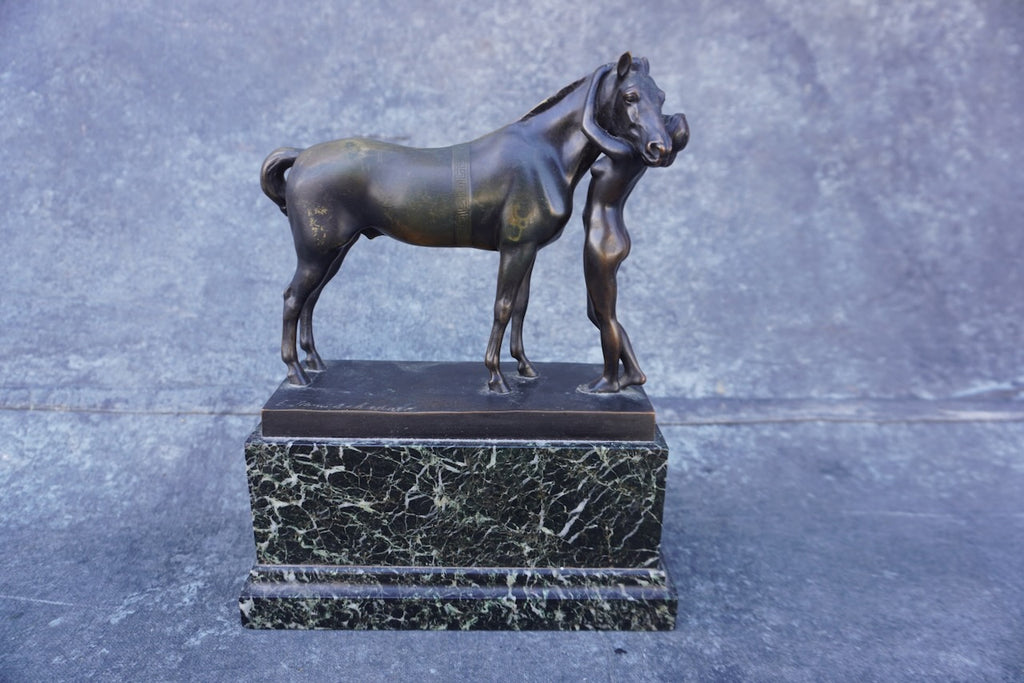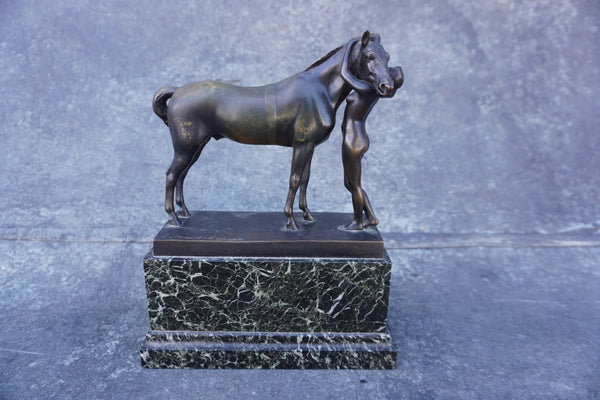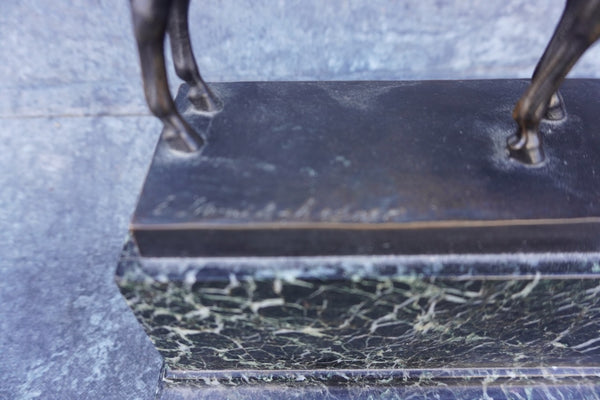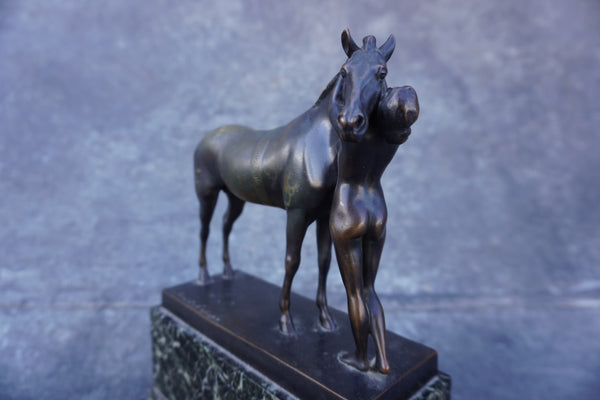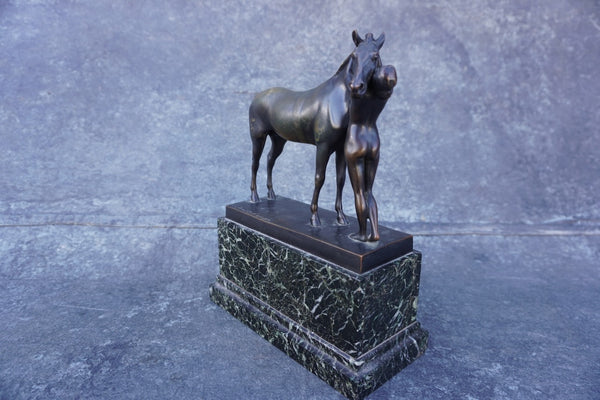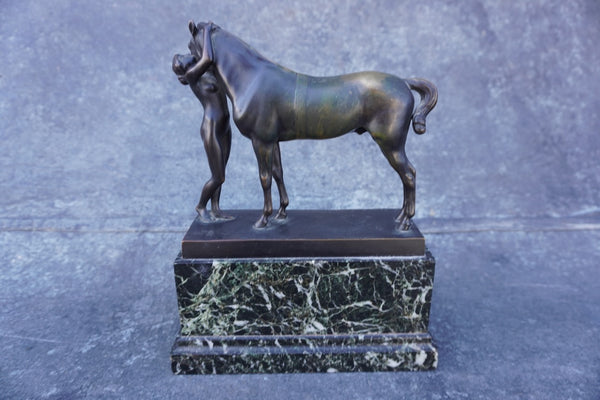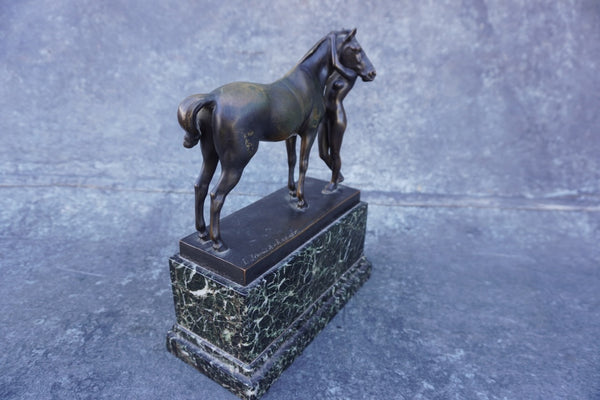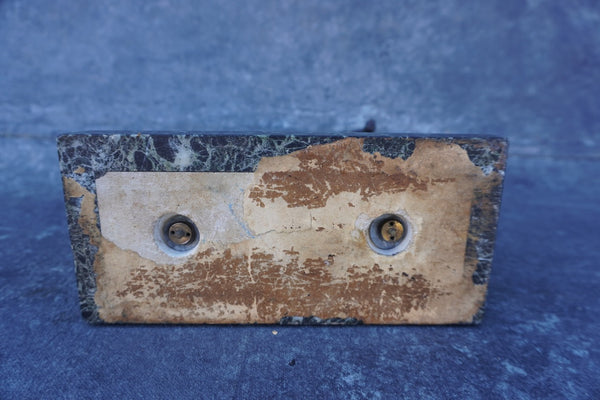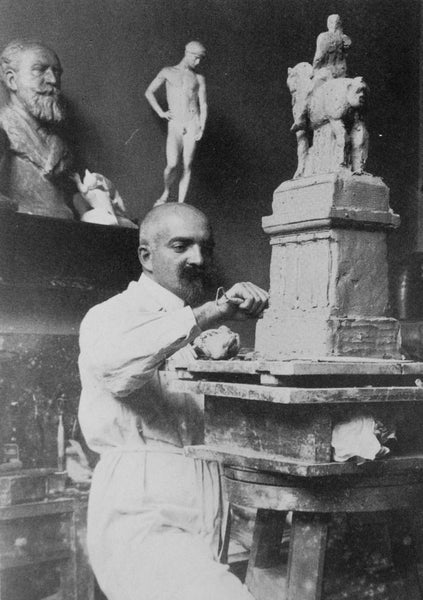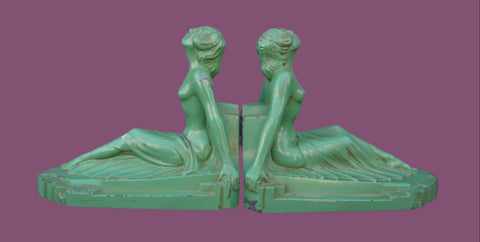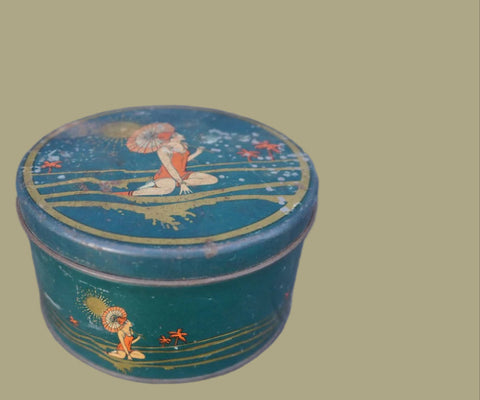Erich Schmidt-Kestner (1877-1941) Amazon with Horse - Bronze A3023
A truly lovely and sensitive work. Measures 10" x 8" x 4". Designed in 1920.
Contact us to arrange shipping insurance. Biography that follows is an AI translation by Wikipedia of the German entry.
Friedrich August Erich Schmidt-Kestner (born January 15, 1877 in Berlin ; † October 24, 1941 in Nordhausen am Harz) was a German sculptor .
Schmidt-Kestner studied at the Berlin Art Academy and at the Düsseldorf Art Academy . In 1904 he received a small gold medal at the Great Berlin Art Exhibition . In 1905 he also received a gold medal at the International Art Exhibition in Munich for his work Striding Girl . After completing his studies, he was awarded the Rome Prize on March 15, 1905 . This gave him the opportunity to live in Italy for two years and deepen his work. He worked as a freelance artist in his hometown of Berlin from 1908 to 1926 until he was 50, only interrupted by the outbreak of the First World War , which he served as a soldier in France , Russia and as an Italian interpreter in the Alpine Corps . One of his studios is still used as such today, on Offenbacher Straße in Berlin-Friedenau .
In order to understand Schmidt-Kestner's entire work , it must be mentioned that 80 percent of it consisted of the design of architectural sculptures . He received many orders from ministries, industry and private individuals. A larger-than-life Hermes statue of him was erected in the town hall of Berlin-Charlottenburg , a popular duck fountain in the city park of Berlin-Schöneberg , a group of foxes in Berlin-Tempelhof , the Paulsen monument in Berlin-Steglitz , the Merkur on the market square in Hanover - Spring. One of his major areas of work was the design of portrait heads . His portraits always show a simple and natural gesture and serenity. Many children's portraits were also created between 1912 and 1921. His five children were born during these years.
In 1926/1927 Schmidt-Kestner was appointed lecturer and head of the sculpture class at the art and crafts school in Königsberg (Prussia) . He enjoyed teaching immensely. A well-known work from his Königsberg period that is still preserved in today's Kaliningrad is thePlaying Greyhounds on the main path of the zoo, of which Schmidt-Kestner was the honorary deputy director for several years. During this time, the artist created hundreds of graphic sheets, drawings and etchings that reflect his art of observing animal life. Above the (art) portal of Königsberg Central Station were five reliefs depicting journeys by water, land and air, arrival and farewell; His bust of Justitia stood on a four-meter-high clinker brick column in the court's inner courtyard. The reliefs were sculpted by Schmidt-Kestner and his student Wilhelm Ernst Ehrich. Ehrich emigrated to America in 1929, where he continued this tradition of public art as director of the Federal Art Project in Buffalo, New York, and as resident sculptor and professor at the University of Rochester. Like Schmidt-Kestner, Ehrich's works also included animals and reliefs for a zoo in Buffalo. However, some of the sculptor's works in Königsberg around 1933 are often kept secret. In the work on the exhibition catalogs of the Königsberg Art Association, edited and published by Rudolf Meyer-Bremen in 1993 , can be found in the catalog of the art association's 62nd art exhibition in the Kunsthalle am Wrangelturm in the year In 1933 a plaster bust of Der Führer for 1,500 Reichsmarks and a portrait of Colonel Abbe , also made of plaster. The Adolf Hitler bust also mentions the great artist lexicon founded by Ulrich Thieme and Felix Becker in 1936. This latter commitment to National Socialism by Schmidt-Kestner may be the reason why he can no longer be found in any artist lexicon after the war.
In 1935 Schmidt-Kestner left East Prussia and accepted a teaching position as a professor at the School of Applied Arts in Kassel , of which he later became director. In Kassel he was also head of the “Supervision Office for the Design of War Memorials”. [1]
During the Second World War , many of Schmidt-Kestner's works fell victim to bombs. The folder with the photos of the architectural sculptures was also lost in the chaos of time. Only a few smaller sculptures, a few reliefs, the mother group in Bad Hersfeld and the sculpture of a miner in Volpriehausen remained. But according to contemporary reports, e.g. B. also the Playing Greyhounds in what is now Russia's Kaliningrad , which was exhibited in the garden of a Soviet general after the war and is now in the city's art gallery. In 1994, a lost relief by Schmidt-Kestner is said to have been renewed by Ernst Lübbert and is located in Neubrandenburg in the ramparts on Große Wollweberstrasse.
The artist's constant effort was to give his works as closed a form as possible. According to his own statement, he did not like to work life-size, preferring to work larger than life or reduced in size. He was in ongoing collaboration with the Selb porcelain company and the Ilmenau porcelain factory Metzler & Ortloff , but works based on Schmidt-Kestner's clay models were also produced at the Royal Porcelain Manufactory in Berlin . For his metal work he used the Hermann Noack foundry in Berlin, the material for his stone work came from the Miltenberg quarry .
On October 24, 1941, Schmidt-Kestner died in Nordhausen , northern Thuringia , at the age of 64. The Kassel Art Association arranged a memorial exhibition in the State Gallery on May 19, 1942, about which the Kassel Latest News wrote on May 19, 1942:
“The extent of the memorial exhibition provides a surprising picture of Schmidt-Kestner's work, which in purely material terms spans the spectrum from the realistic animal sculpture to the large symbolic composition and the reflection of his artistic activity in graphic works. The classical measure, which was always the artist's model, is revealed most purely in the figures of young men with a noble posture (Paris) or the equestrian figures, who enter into a beautiful unity with the horse, filled with currents of power between man and animal. These equestrian pictures reflect one of the artist's special skills: the perfect and true-to-nature depiction of the animals. Since this empathy for the nature of animals was combined with a high level of craftsmanship, we have before us animal sculptures of outstanding truthfulness and harmonious form in these horses, playing dogs, deer and lions.”
In 1984, the East Prussian Cultural Center in the Ellingen Teutonic Order Palace dedicated an exhibition of his works to Schmidt-Kestner together with Edmund May and Franz Andreas Theyne. One of his students was the Hannoversch Münden potter and sculptor Heinz Detlef Wüpper .

